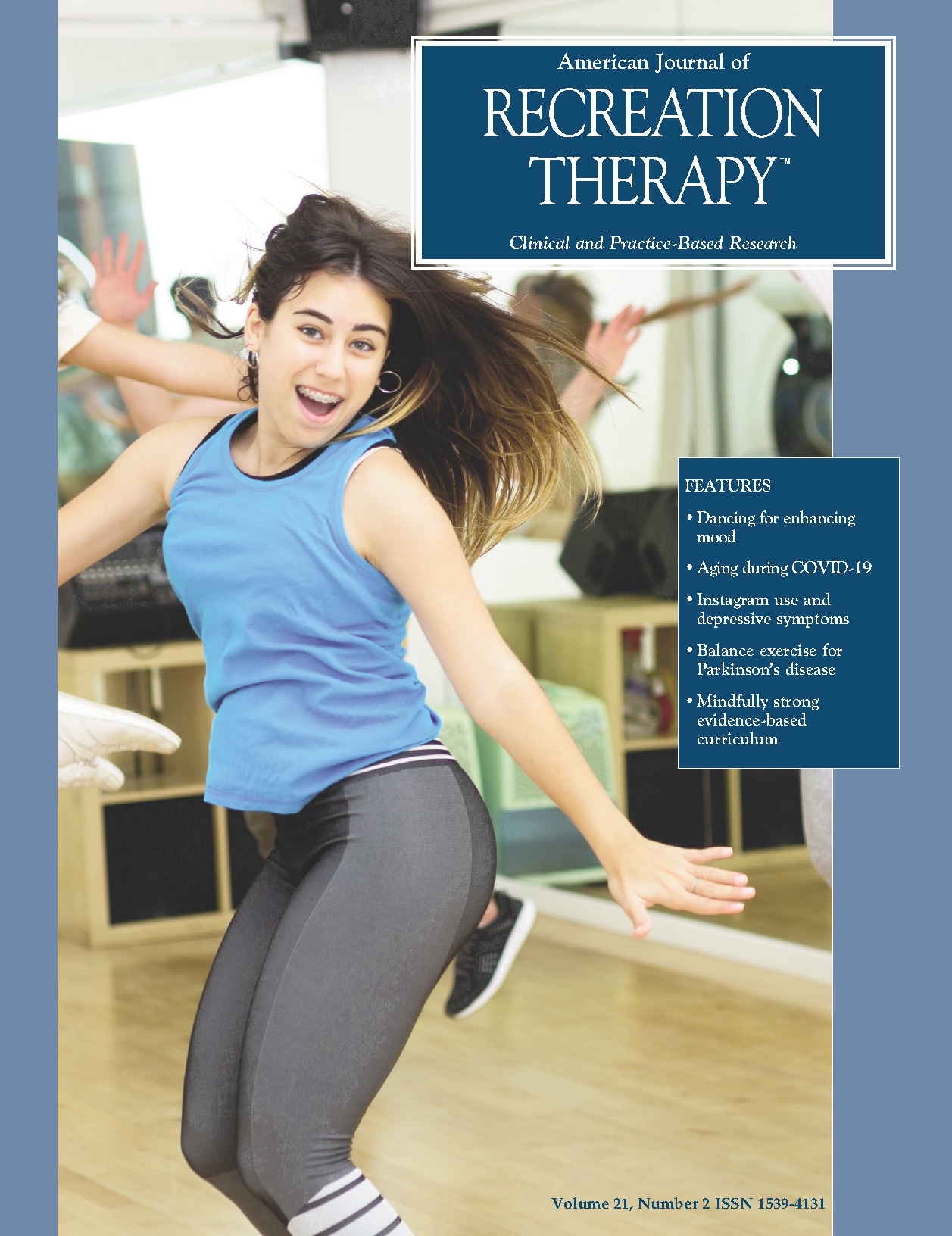Dancing for enhancing mood: Benefits for adolescents on a pediatric behavioral health unit
DOI:
https://doi.org/10.5055/ajrt.2022.0258Keywords:
dance, dance movement, recreational therapy, inpatient, adolescence, interprofessional collaborationAbstract
Adolescent mental health is a significant public health priority. A need exists to identify helpful interventions that are cost-effective and appealing for adolescents. Dance-based interventions have been shown to improve mood and alleviate emotional distress in adolescents. The purpose of this article was to examine the effectiveness of incorporating dance movement sessions (DMSs) into inpatient psychiatric treatment for adolescents. DMS included group stretching, creating dance steps, and performing the completed choreography. The authors assessed pre- and post-DMS self-reported mood. In addition, participants provided feedback about their feelings and opinions after completing a DMS. Overall, differences between pre- and post-mood ratings were statistically significant, suggesting a positive effect on participant mood. We discuss the potential role for DMS for adolescent inpatient settings and for interprofessional collaboration.
References
Behrends A, Müller S, Dziobek I: Moving in and out of synchrony: A concept for a new intervention fostering empathy through interactional movement and dance. Arts Psychother. 2012; 39(2): 107-116.
Erfer T, Ziv A: Moving toward cohesion: Group dance/movement therapy with children in psychiatry. Arts Psychother. 2006; 33(3): 238-246.
Koch S, Kunz T, Lykou S, et al.: Effects of dance movement therapy and dance on health-related psychological outcomes: A meta-analysis. Arts Psychother. 2014; 41(1): 46-64.
Nagata S, McCormick BP, Austin DR: Physical activity as treatment for depression in recreation therapy: Transitioning from research to practice. TRJ. 2020; 54(1): 77-91.
Heber L: Dance movement: A therapeutic program for psychiatric clients. Perspect Psychiatr Care. 1993; 29: 22-29.
Anderson AN, Kennedy H, DeWitt P, et al.: Dance/movement therapy impacts mood states of adolescents in a psychiatric hospital. Arts Psychother. 2014; 41(3): 257-262.
Busch AM, Ciccolo JT, Puspitasari AJ, et al.: Preferences for exercise as a treatment for depression. Mental Health Phys Activity. 2016; 10: 68-72. DOI: 10.1016/j.mhpa.2015.12.004.
Vijay GC, Wilson EC, Suhrcke M, et al.: Are brief interventions to increase physical activity cost-effective? A systematic review. Br J Sport Med. 2015; 50(7): 408-417. DOI: 10.1136/bjsports-2015-094655.
Shaw SM, Kleiber DA, Caldwell LL: Leisure and identity formation in male and female adolescents: A preliminary examination. J Leisure Res. 1995; 27(3): 245-263.
Larson R: Toward a psychology of positive youth development. Am Psychol. 2000; 55: 170-183.
Duell N, Steinberg L: Positive risk taking in adolescence. Child Dev Perspect. 2019; 13(1): 48-52.
Reyna VF, Farley F: Risk and rationality in adolescent decision making: Implications for theory, practice, and public policy. Psychol Sci Public Interest. 2006; 7(1): 1-44.
Diana C, Cristina B, Azucena G-P, et al.: Experience-sampling methodology with a mobile device in fibromyalgia, Int J Tele Appl. 2012; 2012: 1-7.
Sy T, Côté S, Saavedra R: The contagious leader: Impact of the leader’s mood on the mood of group members, group affective tone, and group processes. J Appl Psychol. 2005; 90(2): 295-305.
Pickett K, Kendrick T, Yardley L: “A forward movement into life”: A qualitative study of how, why and when physical activity may benefit depression. Mental Health Phys Activity. 2017; 12: 100-109. DOI: 10.1016/j.mhpa.2017.03.004.
Ansa BE, Zechariah S, Gates AM, et al.: Attitudes and behavior towards interprofessional collaboration among healthcare professionals in a large academic medical center. Healthcare (Basel, Switzerland). 2020; 8(3): 323. DOI: 10.3390/healthcare8030323.
Berget B, Grepperud S, Aasland OG, et al.: Animal-assisted interventions and psychiatric disorders: Knowledge and attitudes among general practitioners, psychiatrists, and psychologists. Soc Anim. 2013; 21(3): 284-293.
Hoagwood KE, Acri M, Morrissey M, et al.: Animal-assisted therapies for youth with or at risk for mental health problems: A systematic review. Appl Dev Sci. 2017; 21(1): 1-13.
Stefanini MC, Martino A, Allori P, et al.: The use of animal-assisted therapy in adolescents with acute mental disorders: A randomized controlled study. Complement Ther Clin Practice. 2015; 21(1): 42-46.
Cravero JP, Fanciullo GJ, McHugo GJ, et al.: The validity of the computer face scale for measuring pediatric pain and mood. Paediatr Anaesth. 2013; 23(2): 156-161.
Ahlse J, Nilsson F, Sandström N: It’s time to TikTok: Exploring generation Z’s motivations to participate in # challenges. Student thesis. 2020.
Klug D: It took me almost 30 minutes to practice this. Performance and production practices in dance challenge videos on TikTok. Transfer Learning for Human & AI. 2020.
Published
How to Cite
Issue
Section
License
Copyright 2000-2025, Weston Medical Publishing, LLC and American Journal of Recreation Therapy. All Rights Reserved.


